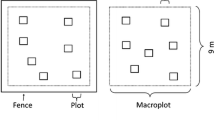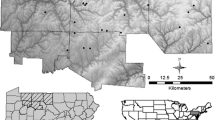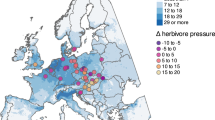Abstract
Debate on the relative importance of competition for resources and trophic interactions in shaping the biological diversity of living communities remains unsettled after almost a century. Recently, dramatic increases in ungulate populations have provided a useful quasi-experiment on the effects of unrestrained ungulates on forest ecology. The islands of Haida Gwaii (Canada) offer a unique situation to investigate the potential of large herbivores to control temperate forest community structure and diversity. Black-tailed deer Odocoileus hemionus Merriam, native to adjacent mainland areas of British Columbia, were introduced in 1878 and spread to all but a few islands. Because deer were not native to the archipelago, islands that still lack deer provide a rare instance of temperate forest vegetation and fauna that developed in the absence of large herbivores. The colonisation of different islands at different times, and the absence of significant predation allow us to assess whether and how a large herbivore can exert “top-down” control on vegetation and its associated fauna. We studied plant communities in forest interior and shoreline, on seven small islands of varying browse history. Three islands were untouched by deer, deer had been resident for about 15 years on two, and on another two deer had been present for more than 50 years. Without deer, vegetation in the understorey and/or shrub layer was dense or very dense. Structure and composition varied markedly within and between shoreline and interior communities. Without deer, shoreline communities were dominated by species absent from islands with deer. Where deer had been present for less than 20 years most plant species characteristic of shorelines on islands without deer were already absent or scarce, but in the forest interior species richness was less affected and extensive shrub thickets remained. On islands where deer had been present for >50 years vegetation below the browse line was extremely simplified, converging in both forest interior and shoreline towards an open assemblage of a few deer-tolerant species, basically two coniferous trees. This top down effect on the plant community reflected up the food chain so that understorey invertebrate and shrub-dependent songbird communities became simplified. In contrast, species densities of litter arthropods (especially weevils and millipedes) were highest where deer were present for >50 years. Canopy birds were unaffected by deer presence. In the absence of predators, major climatic stress or other means to control the herbivore, deer browsing created greatly simplified plant and animal communities.




Similar content being viewed by others
References
Alaback P (1990) Comparative ecology of temperate rain forests of the Americas along analogous climatic gradients. US Department of Ariculture Forest Service, Pacific Northwest Research Station, Juneau
Allombert S, Stockton SA, Martin JL (2005a) A natural experiment on the impact of overabundant deer on forest invertebrates. Conserv Biol 19:1917–1929
Allombert S, Gaston AJ, Martin JL (2005b) A natural experiment on the impact of overabundant deer on songbird populations. Biol Conserv 126:1–13
Alverson WS, Waller DM, Solheim SL (1988) Forests too deer—edge effects in Northern Wisconsin. Conserv Biol 2:348–358
Anderson RC, Loucks OL (1979) White-tail deer (Odocoileus-Virginianus) influence on structure and composition of Tsuga-canadensis forests. J Appl Ecol 16:855–861
Arcese P, Sogge MK, Marr AB, Patten MA (2002) Song sparrow (Melospiza melodia). In: Poole A, Gill F (eds) The birds of North America 704. The Birds of North America Inc, Philadelphia
Augustine DJ, McNaughton SJ (1998) Ungulate effects on the functional species composition of plant communities: herbivore selectivity and plant tolerance. J Wildl Manag 62:1165–1183
Augustine DJ, Frelich LE, Jordan PA (1998) Evidence for two alternate stable states in an ungulate grazing system. Ecol Appl 8:1260–1269
Banner A, Pojar J, Schwab JW, Towbridge R (1989) Vegetation and soils of the Queen Charlotte Islands: recent impacts of development. In: Scudder GEE, Gessler N (eds) The outer shores. Queen Charlotte Islands Museum Press, Skidegate, pp 261–281
Bibby CJ (1992) Bird census techniques. Academic Press, London
Boutin C, Keddy PA (1993) A functional classification of wetland plants. J Veg Sci 4:591–600
Breitenmoser U (1998) Large predators in the Alps: The fall and rise of man’s competitors. Biol Conserv 83:279–289
Brown JS, Laundré JW, Gurung M (1999) The ecology of fear: optimal foraging, game theory, and trophic interactions. J Mammal 80:385–399
Bunnell FL (1990) Ecology of black-tailed deer. In: Nyberg JB, Janz DW (eds) Deer and elk habitat in Coastal Forests of southern B.C. Special Report Series. Research Branch B.C. Ministry of Forests, Victoria, pp 31–63
Burt WH (1943) Territorially and home range concepts as applied to mammals. J Mammal Baltimoro 24:346–352
Coates KD, Pollack JC, Barker JE (1985) The effect of deer browsing on the early growth of three conifer species in the Queen Charlotte Islands. BC Ministry of Forests, Victoria
Côté SD, Rooney TP, Tremblay I, Dussault C, Waller DM (2004) Ecological impacts of deer overabundance. Ann Rev Ecol Evol Syst 35:113–147
Coughenour MB (1985) Graminoid responses to grazing by large herbivores—adaptations, exaptations, and interacting processes. Ann MO Bot Garden 72:852–863
Cowan IM (1945) The ecological relationships of the food of the Columbian black-tailed deer, Odocoileus-Hemionus-Columbianus (Richardson), in the coast forest region of Southern Vancouver-Island, British-Columbia. Ecol Monogr 15:109–139
Cowan IM (1989) Birds and mammals on the Queen Charlotte Islands. In: Scudder GGE, Gessler N (eds) The outer shores. Based on the proceedings of the Queen Charlotte Islands 1st international scientific symposium. University of British Columbia, August 1984, pp 175–186
DeCalesta DS (1994) Effect of white-tailed deer on songbirds within managed forests in Pennsylvania. J Wildl Manag 58:711–718
Diamond JM (1983) Laboratory, field and natural experiments. Nature 304:586–587
Elton C (1927) Animal ecology. Sidgwick and Jackson, London. Reprinted in 2001 by The University of Chicago Press, ISBN 0-226-20639-4
Epstein EW, Smith W, Dobberpuhl J, Galvin A (1999) Biotic inventory and analysis of the Brulé River State Forest. Wisconsin Department of Natural Resources, Bureau of Endangered Resources, Madison
Estes J, Palmisano J (1974) Sea otters: their role in structuring nearshore communities. Science 185:1058–1060
Frelich LE, Lorimer CG (1985) Current and predicted long-term effects of deer browsing in Hemlock Forests in Michigan, USA. Biol Conserv 34:99–120
Gaston AJ, Stockton SA, Smith JL (2006) Species-area relationships and the impact of deer-browse in the complex phytogeography of the Haida Gwaii archipelago (Queen Charlotte Islands), British Columbia. Ecoscience 13:511–522
Gause GF (1934) The struggle for existence. Williams & Wilkins, Baltimore. Reprinted in 2003 by Dover Pheonix Editions, Mineola
Gill RMA, Fuller RJ (2007) The effects of deer browsing on woodland structure and songbirds in lowland Britain. Ibis 149:119–127
Gillingham MP, Parker KL, Hanley TA (2000) Partial consumption of Shield Fern, Dryopteris dilatata, rhizomes by black-tailed deer, Odocoileus hemionus sitkensis, and its potential implications. Canadian Field-Naturalist 114:21–25
Golumbia T, Bland L, Morre K, Bartier P (2008) History and current status of introduced species on Haida Gwaii. In: Gaston AJ, Golumbia TE, Martin JL, Sharpe ST (eds) Lessons from the islands: introduced species and what they tell us about how ecosystems work. Proceedings from the Research Group on Introduced Species 2002 Symposium, Queen Charlotte City, Queen Charlotte Islands, British Columbia. Canadian Wildlife Service, Environment Canada, Ottawa, pp 8–31
Gotelli NJ, Colwell RK (2001) Quantifying biodiversity: procedures and pitfalls in the measurement and comparison of species richness. Ecol Lett 4:379–391
Greenwald KR, Petit LJ, Waite TA (2008) Indirect effects of a keystone herbivore elevate local animal diversity. J wildl Manag 72:1318–1321
Hairston NG, Smith FE, Slobotkin LB (1960) Community structure, population control, and competition. Am Nat 94:421–425
Hamel PB (1984) Comparison of variable circular plot and spotmapping censusing methods in temperate deciduous forest. Ornis Scandinavica 15:266–274
Hitchcock CL, Gronquist A (1973) Flora of the Pacific Northwest. University of Washington Press, Seattle
Horsley SB, Marquis DA (1983) Interference by weeds and deer with Allegheny hardwood reproduction. Can J For Res—Revue Canadienne de Recherche Forestiere 13:61–69
Horsley SB, Stout SL, DeCalesta DS (2003) White-tailed deer impact on the vegetation dynamics of a northern hardwood forest. Ecol Appl 13:98–118
Huston M (1979) General hypothesis of species-diversity. Am Nat 113:81–101
Jongman RHG, Ter Braak CJF, Van Tongeren OFR (1995) Data analysis in community and landscape ecology. Cambridge University Press, Cambridge
Keddy P (2005) Putting the plants back into plant ecology: six pragmatic models for understanding and conserving plant diversity. Ann Bot 96:177–189
Kuiters AT, Mohren GMJ, VanWieren SE (1996) Ungulates in temperate forest ecosystems. For Ecol Manag 88:1–5
Leopold A, Sowls LK, Spencer DL (1947) A survey of over-populated deer ranges in the United-States. J Wildl Manag 11:162–177
Lomer F, Douglas GW (1999) Additions to the vascular plant flora of the Queen Charlotte Islands, British Columbia. Can Field Nat 113:235–240
MacArthur R, Levins R (1967) The limiting similarity, convergence and divergence of coexisting species. Am Nat 101:377–385
MacArthur RH, Wilson EO (1967) the theory of island biogeography. Princeton Universty Press, New Jersey
Marchant JH, Hudson R, Carter SP, Whitttington P (1990) Population trends in British breeding birds. British Trust for Ornithology, Tring
Martin JL, Baltzinger C (2002) Interaction among deer browsing, hunting, and tree regeneration. Can J For Res—Revue Canadienne de Recherche Forestiere 32:1254–1264
Martin JL, Daufresne T (1999) Introduced species and their impacts on the forest ecosystem of Haida Gwaii. In: Wiggins GG (ed) Proceeding of the cedar symposium, May 28–30, 1996, Queen Charlotte Islands. B.C. Ministry of Forests MRO94, Victoria, pp 69–85
Martin JL, Gaston AJ, Hitier S (1995) The effect of island size and isolation on old growth forest habitat and bird diversity in Gwaii Haanas, Queen Charlotte Islands, Canada. Oikos 72:115–131
McCaffery K, Tranetzki J, Piechura J (1974) Summer foods of deer in Northern Wisconsin. J Wildl Manag 38:215–219
McInnes PF, Naiman RJ, Pastor J, Cohen Y (1992) Effects of moose browsing on vegetation and litter of the boreal forest, Isle Royale, Michigan, USA. Ecology 73:2059–2075
McKinney ML, Lockwood JL (1999) Biotic homogenization: a few winners replacing many losers in the next mass extinction. Trends Ecol Evol 14:450–453
McShea WJ, Underwood HB, Rappole JH (eds) (1997) The science of overabundance: deer ecology and population management. Smithsonian Institute, Washington
Miller SG, Bratton SP, Hadidian J (1992) Impacts of white-tailed deer on endangered and threatened plants. Nat Areas J 12:67–74
Mladenoff DJ, Stearns F (1993) Eastern Hemlock regeneration and deer browsing in the northern Great Lakes region: a re-examination and model simulation. Conserv Biol 7:889–900
Moser B, Schütz M (2006) Tolerance of understorey plants subject to herbivory by roe deer. Oikos 114:311–321
Mueller-Dombois D, Ellenberg H (1974) Aims and methods of vegetation ecology. John Wiley bird species diversity per island studied and Sons, New York
Munro JA (1935) The introduction of coast deer, ring-necked pheasant on Graham Island British Columbia. Report of the provincial game commission for the year ended December 31. B.C Game Commission, Victoria
Oliver I, Beattie AJ (1996) Invertebrate morphospecies as surrogates for species: a case study. Conserv Biol 10:99–109
Osgood WH (1901) Natural history of the Queen Charlotte islands, British Columbia. North Am Fauna 21:7–50
Pace ML, Cole JJ, Carpenter SR, Kitchell JF (1999) Trophic cascades revealed in diverse ecosystems. Trends Ecol Evol 14:483–488
Paine RT (1969) A note on trophic complexity and community stability. Am Nat 103:91–93
Pojar J (1999) The effects of deer browsing on the plant life of Haida Gwaii. In: Wiggins GG (ed) Proceeding of the cedar symposium, May 28–30, 1996, Queen Charlotte Islands. B.C. Ministry of Forests MRO94, Victoria, pp 90–97
Pojar J, MacKinnon A (1994) Plants of coastal British Columbia; including Washington, Oregon and Alaska. Lone Pine, Vancouver
Pojar J, Lewis T, Roemer H, Wilford DJ (1980) Relationships between introduced black-tailed deer and the plant life in the Queen Charlotte Islands, British Columbia. Unpublished report, B.C. Ministry of Forests, Smithers, BC
Polis GA (1999) Why are parts of the world green? Multiple factors control productivity and the distribution of biomass. Oikos 86:3–15
Putman RJ (1996) Ungulates in temperate forest ecosystems: perspectives and recommendations for future research. For Ecol Manag 88:205–214
Ricketts TH, Dinerstein E, Olson DM (1999) Terrestrial ecoregions of North America: a conservation assessment. Island Press, Washington
Rodway MS, Lemon MJF, Kaiser GW (1988) British Columbia seabird colony inventory: report#1—East Coast Moresby Island. Technical Report Series No. 50. Pacific and Yukon Region, Canadian Wildlife Service
Rooney TP (1997) Escaping herbivory: refuge effects on the morphology and shoot demography of the clonal forest herb Maianthemum canadense. J Torrey Bot Soc 124:280–285
Rooney TP (2001) Deer impacts on forest ecosystems: a North American perspective. Forestry 74:201–208
Rooney TP, Dress WJ (1997) Species loss over sixty-six years in the ground-layer vegetation of heart’s content, an old-growth forest in Pennsylvania USA. Nat Areas J 17:297–305
Rooney TP, Wiegmann SM, Rogers DA, Waller DM (2004) Biotic impoverishment and homogenization in unfragmented forest understory communities. Conserv Biol 18:787–798
SAS Institute (2001) SAS/STAT. Release 8.2. SAS Institute, Cary
Spence JR, Niemelä JK (1994) Sampling carabid assemblages with pitfall-traps: the madness and the method. Can Entomol 126:881–894
Standen V (2000) The adequacy of collecting techniques for estimating species richness of grassland invertebrates. J Appl Ecol 37:884–893
Stevens J (1986) Applied multivariate statistics for the social sciences. Erlbaum, Hillsdale
Stockton SA, Gaston AJ, Martin JL (2001) Where have all the flowers gone? The impact of introduced black-tailed deer on the shoreline vegetation of Haida Gwaii, British Columbia. In: Gaston AJ (ed) Laskeek Bay research 10. Laskeek Bay Conservation Society, Queen Charlotte City, pp 31–43
Stockton SA, Allombert S, Gaston AJ, Martin JL (2005) A natural experiment on the effects of high deer densities on the native flora of coastal temperate rain forests. Biol Conserv 126:118–128
Stroh N, Baltzinger C, Martin JL (2008) Deer prevent western redcedar (Thuya plicata) regeneration in old-growth forests of Haida Gwaii: is there a potential for recovery? For Ecol Manag 255:3973–3979
Suominen O (1999) Impact of cervid browsing and grazing on the terrestrial gastropod fauna in the boreal forests of Fennoscandia. Ecography 22:651–658
Taylor RL (1989) Vascular plants of the Queen Charlotte Islands. In: Scudder GEE, Gessler N (eds) The outer shores. Queen Charlotte Islands Museum Press, Skidegate, pp 121–130
ter Braak CJF, Smilauer P (1998) CANOCO reference manual and user’s guide to Canoco for Windows: software for canonical community ordination (version 4.0). Microcomputer Power, Ithaca
Tilghman NG (1989) Impacts of white-tailed deer on forest regeneration in Northwestern Pennsylvania. J Wildl Manag 53:524–532
Vila B, Martin JL (2008) Spread and history of deer impact: the memory of the woody plants. In: Gaston AJ, Golumbia TE, Martin JL, Sharpe ST (eds) Lessons from the Islands: introduced species and what they tell us about how ecosystems work. Proceedings from the research group on introduced species 2002 symposium, Queen Charlotte City, Queen Charlotte Islands. British Columbia Canadian Wildlife Service, Environment Canada, Ottawa, pp 57–63
Vila B, Vourc’h G, Gillon D, Martin JL, Guibal F (2002) Is escaping deer browse just a matter of time in Picea sitchensis ? A chemical and dendroecological approach. Trees Struct Funct 16:488–496
Vila B, Torre F, Martin JL, Guibal F (2003) Response of young Tsuga heterophylla to deer browsing: developing tools to assess deer impact on forest dynamics. Trees Struct Funct 17:547–553
Vila B, Guibal F, Torre F, Martin JL (2004a) Assessing spatial variation in browsing history by means of fraying scars. J Biogeogr 31:987–995
Vila B, Torre F, Guibal F, Martin JL (2004b) Can we reconstruct browsing history and how far back? Lessons from Vaccinium parvifolium Smith in Rees. For Ecol Manag 201:171–185
Vila B, Guibal F, Torre F, Martin JL (2005) Can we reconstruct deer browsing history and how? Lessons from Gaultheria shallon Pursh. Ann For Sci 62:153–162
Vourc’h G, Vila B, Gillon D, Escarre J, Guibal F, Fritz H, Clausen TP, Martin JL (2002) Disentangling the causes of damage variation by deer browsing on young Thuja plicata. Oikos 98:271–283
Waller DM (2008) Lessons from the mainland: white-tailed deer impacts and the challenge of managing a hyperabundant herbivore. In: Gaston AJ, Golumbia TE, Martin JL, Sharpe ST (eds) Lessons from the islands: introduced species and what they tell us about how ecosystems work. Proceedings from the Research Group on Introduced Species 2002 Symposium, Queen Charlotte City, Queen Charlotte Islands. British Columbia Canadian Wildlife Service, Environment Canada, Ottawa, pp 135–147
Waller DM, Alverson WS (1997) The white-tailed deer: a keystone herbivore. Wildl Soc Bull 25:217–226
Wallmo OC (1981) Mule and balck-tailed deer distribution and habitats. In: Wallmo OC (ed) Mule and black-tailed deer of North America. University of Nebraska, pp, pp 1–25
Wilson JB (1999) Guilds, functional types and ecological groups. Oikos 86:507–522
Acknowledgments
This is a publication from the Research Group on Introduced Species (RGIS). Funding was provided by the Canada—British Columbia South Moresby Forest Replacement Account (SMFRA); contract # SMFRA99DQC-002, SMFRA Project 24.2, “Pattern of Western Red Cedar Regeneration,” and by Forest Renewal British Columbia (FRBC), research award: PA97335-BRE and by the International Program of Scientific Collaboration (PICS 389) from the Centre National de la Recherche Scientifique (CNRS) and the French Ministry of Foreign Affairs. The Canadian Wildlife Service of Environment Canada and the Laskeek Bay Conservation Society (LBCS) provided logistical support. The Archipelago Management Board (AMB) and the B.C. Department of Lands, Forests and Parks provided research permits. Special thanks to Liann Bobechko, Rob Kelly, Isabel Buttler, Ian Fuhr, Denis Chrétien, Nadine Wilson, Céline Boutin, Todd Golumbia, Sean Sharpe, Jim Pojar, Don Waller, and Barb Rowsell our project coordinator, for help and insight.
Author information
Authors and Affiliations
Corresponding author
Rights and permissions
About this article
Cite this article
Martin, JL., Stockton, S.A., Allombert, S. et al. Top-down and bottom-up consequences of unchecked ungulate browsing on plant and animal diversity in temperate forests: lessons from a deer introduction. Biol Invasions 12, 353–371 (2010). https://doi.org/10.1007/s10530-009-9628-8
Received:
Accepted:
Published:
Issue Date:
DOI: https://doi.org/10.1007/s10530-009-9628-8




